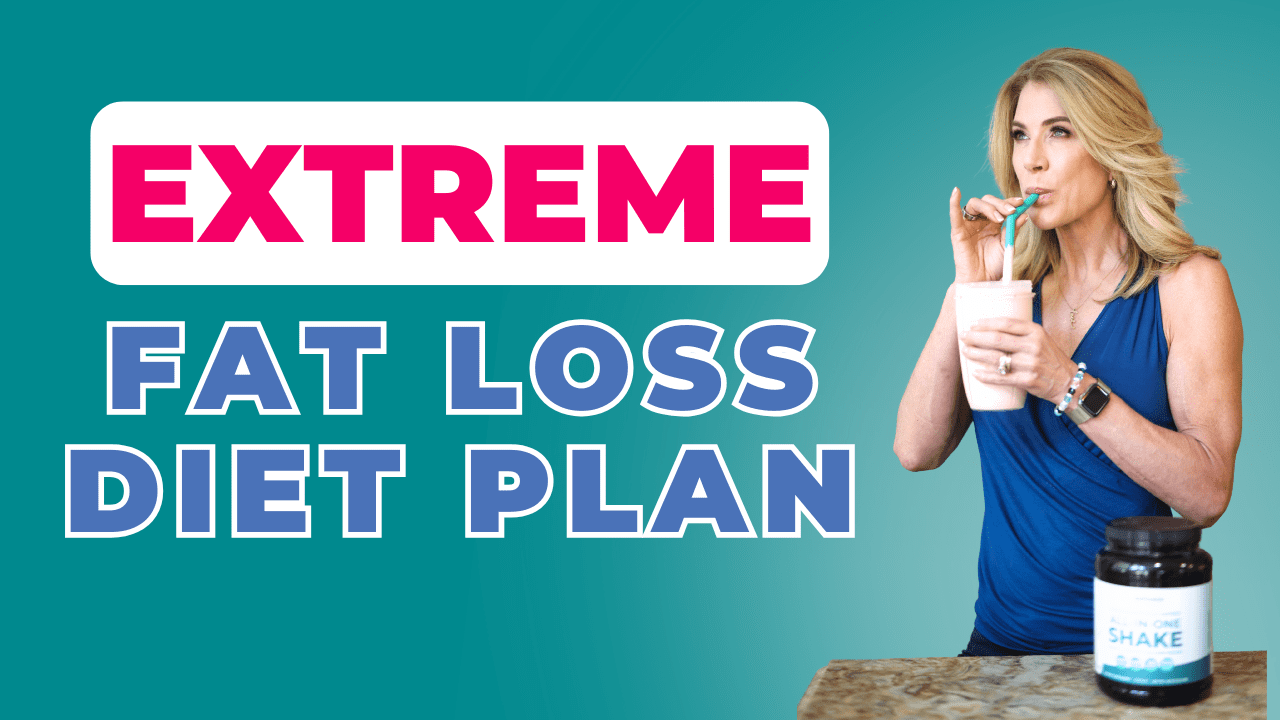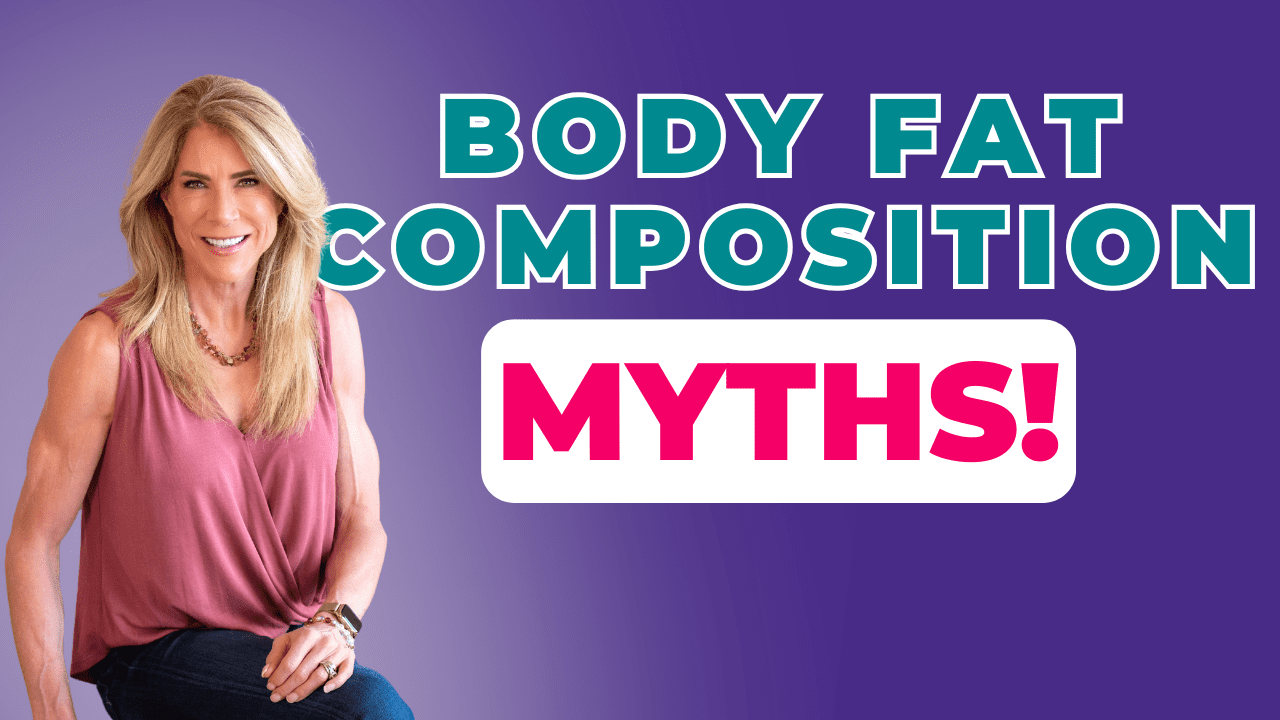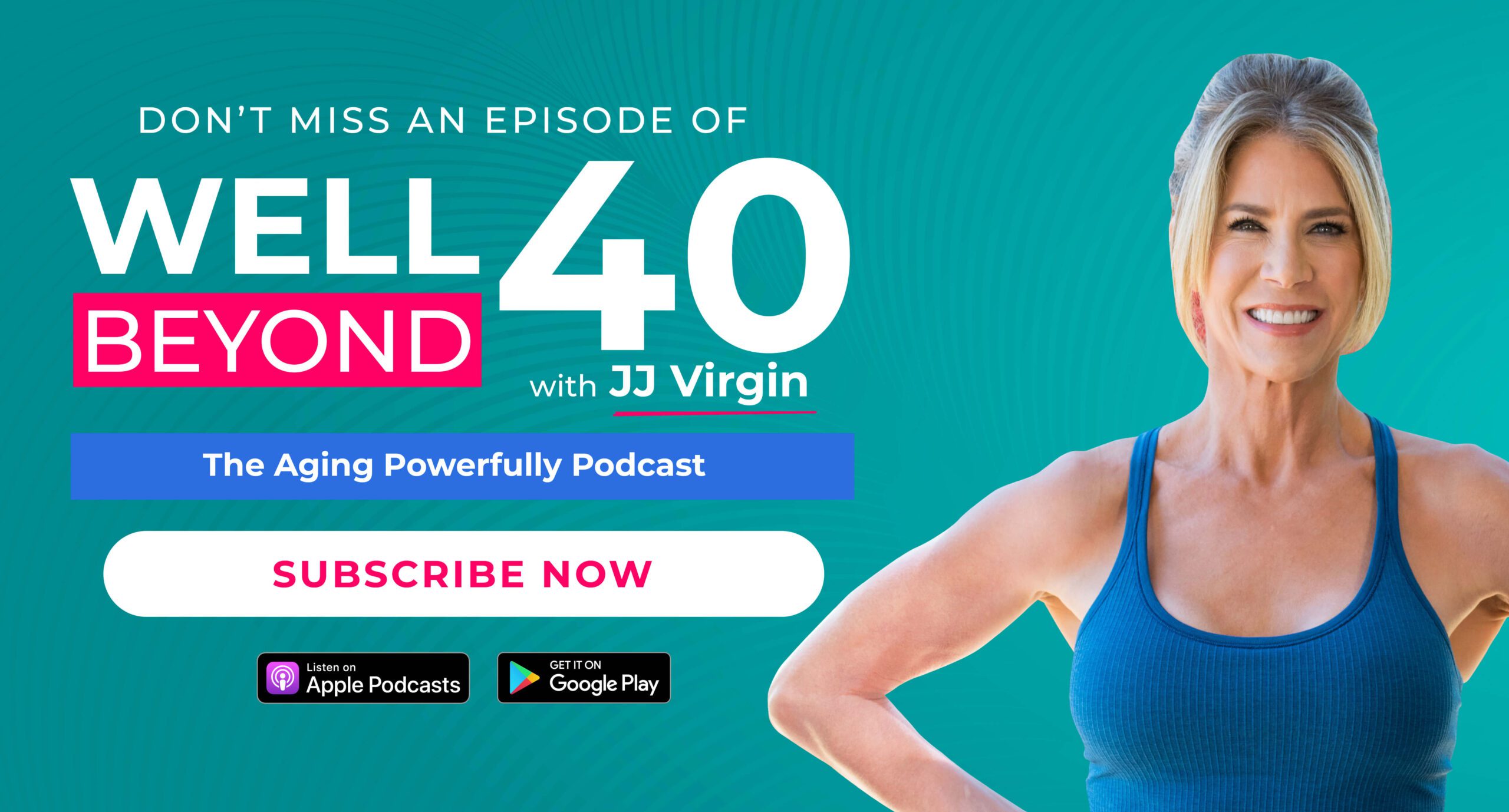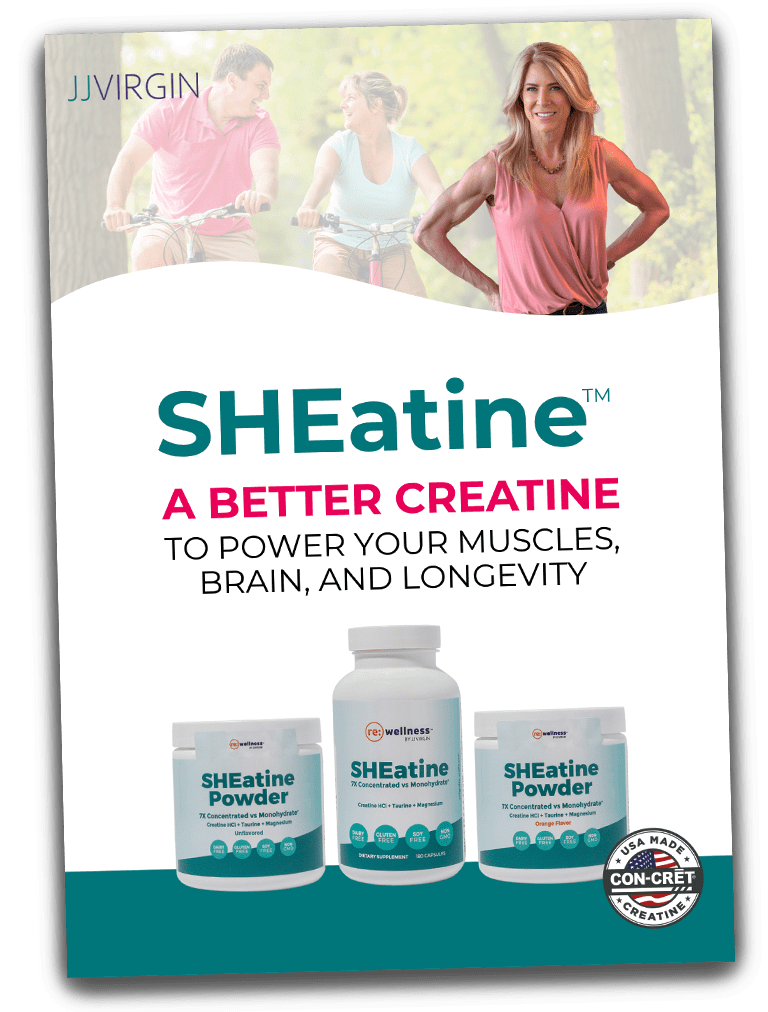The Metabolic Protection Plan: How to Lose Fat Without Sacrificing Muscle
After 30+ years of helping women transform their bodies, I’m sharing the exact fat loss strategy that actually works—and it’s not what you’ve been told. If you’re tired of the “eat less, exercise more” approach that left you exhausted and metabolically damaged (like it did for 95% of people who try it), this episode is your game-changer. I’m breaking down why calories aren’t just calories, how to protect your precious metabolism-boosting muscle during fat loss, and the specific workout and nutrition formula that helps women over 40 build muscle while burning fat—without spending hours in the gym or feeling deprived.
Drawing from my work with thousands of clients and the latest metabolic research (including what really happened to those Biggest Loser contestants), I’m giving you my complete blueprint for sustainable fat loss. This isn’t about quick fixes—it’s about creating a body composition that supports you as you age powerfully. I’ll walk you through my personal daily eating routine, the exact resistance training moves that give you the most bang for your buck, and my secret weapon: cycling caloric restriction that prevents metabolic adaptation while still accelerating fat loss.
What you’ll learn:
- Why 25-40% of weight loss on traditional diets comes from muscle (and how to prevent this metabolic disaster)
- The “trifecta for satiety” that naturally controls hunger and stabilizes blood sugar
- My specific protein formula: exactly how much you need per pound of body weight to build muscle and burn fat for women over 40
- The 3 critical roles muscle plays beyond just looking toned (metabolic spanx, sugar sponge, and myokine messenger)
- My exact resistance training routine: 6 compound movements that transform your body in just 3 sessions per week
- Why ultra-processed foods sabotage your metabolism through lower thermic effect
- The cycling caloric restriction strategy that prevents metabolic adaptation while accelerating fat loss
- How to structure meals for optimal muscle retention during fat loss (with my personal meal examples)
Love the Podcast? Here’s what to do:
Make My Day & Share Your Thoughts!
- Subscribe to the podcast & leave me a review
- Text a screenshot to 813-565-2627
- Expect a personal reply because your voice is so important to me.
Join 55,000+ followers who make this podcast thrive.
Want to listen to the show completely ad-free?
- Go to subscribetojj.com
- Enjoy the VIP experience for just $4.99/month or $49.99/year (save 17%!)
- Click “TRY FREE” and start your ad-free journey today!
Resources Mentioned in this episode
7-Day Eat Protein First Challenge
Reignite Wellness™ Collagen Peptides Powder
Reignite Wellness™ Extra Fiber
Reignite Wellness™ Plant-Based & Paleo-Inspired All-In-One Shakes
Download my free Resistance Training Cheat Sheet
Try Rx Sugar use code JJVIRGIN20 for 20% off
Get 60 FREE delicious, protein-packed shake recipes in my Eat Protein First Smoothie Guide
TRX Resistance Training Equipment Free Shipping on all orders $99+
Episode Sponsors:
Try Qualia risk free for up to 100 days and code VIRGINWELLNESS for an additional 15% off
794_YT
===
[00:00:00] JJ Virgin: Are you looking to build an extreme fat loss diet plan? Let’s talk about that. You’ve heard it, you’ve tried it. Eat less, exercise more. How’s it worked for you? Yeah. If you’re like 95% of the people out there, it didn’t work so well, and there’s a couple of reasons why. Now, here’s the thing. Calories do count.
[00:00:21] JJ Virgin: However, where they come from counts more. So that’s the first part of this, and here’s how I can show you that. Number one, we have three parts to our metabolism. So we have the resting metabolic rate, we have the thermic effect of food, and then we have activity. We’re gonna talk thermic effect of food.
[00:00:38] JJ Virgin: Here’s what’s interesting. If you’re eating a high ultra processed diet, like 60 to 70% of Americans do. Ultra processed foods have a lower thermic effect of food. So if you’re eating those calories, you’re getting less of a caloric expenditure. Contrast that with protein. Protein is the most thermic of the three macronutrients.
[00:00:59] JJ Virgin: Protein, fat, and carbs. You burn about 25% of the calories from protein just by having to digest and assimilate the protein and then look at. Fibery carbohydrates where the fiber isn’t even coming in. Like when you really look at it, you should probably be just looking at net carbs because those fibery carbs, most of them are not getting absorbed, right?
[00:01:19] JJ Virgin: They’re going through the system, so you can’t just look at calories as calories. There’s more to it than that. Calories do count, but again, where they comes from counts more. But let’s look at the other side of the equation, which is move more. Our bodies really like to maintain homeostasis. They like to stay where they’re at.
[00:01:37] JJ Virgin: And so one of the things that happens is you start to lower calories and move more is that your body starts. Slow down its metabolic rate. It doesn’t do it acutely, but it does it over time. When you’re chronically doing this, it’s something called metabolic adaptation. It’s what happened to the biggest losers where at the end of their time of exercising hard and eating less, they had about 500 calories, a less a day that they were burning than they should have been burning, which is the last thing you wouldn’t want to have happen, and probably why 95% of people who go on a weight loss program.
[00:02:11] JJ Virgin: Gain it back, and that is what we’re here to avoid. Yes, we want you to lose fat, but we wanna make sure that you keep it off. So one of the keys to keeping fat off is by making sure that you are protecting and better yet, building your skeletal muscle during a fat loss phase. Now, here’s the reality. If you are not paying attention to this, 25, 40% of the weight that you will lose on a weight loss program, not a fat loss program will be from skeletal muscle.
[00:02:39] JJ Virgin: And this. Devastate your metabolism. So I talked about the thermic effect of food as one of the levers for your overall total daily energy expenditure. One of the other levers is your resting metabolic rate. Your resting metabolic rate is influenced by your height, by your weight, by your genetics, by your uh, gender.
[00:03:01] JJ Virgin: However, there is something that you can modify for your resting metabolic rate, and that is your muscle mass. Every pound of skeletal muscle mass will burn a little bit more calories per day. I’ve heard people say it’s a hundred more calories a day. It’s not, it’s probably about 10, but it adds up and it makes a difference, especially if you’re going the wrong way and losing that skeletal muscle mass.
[00:03:23] JJ Virgin: So the big thing we wanna make sure of is that we are holding onto that muscle. Now there’s more to it than just how it holds everything in tighter and boosts your metabolic rate. I call that your. Metabolic Spanx. It also acts like a sugar sponge. Here’s what’s cool about muscle. In muscle. We store carbohydrates as glycogen so that we have them for energy during our next big workout.
[00:03:44] JJ Virgin: And so when you’re working out, you are using up these glycogen stores and after workouts, you’re gonna refuel those. So that gives your carbohydrates a place to go rather than. Going into your belly fat. So think of your muscle as metabolic span and a sugar sponge. And there’s one more thing that muscle does great for us, and that is it’s a multitasking messenger where every time your muscles contract, they release things called myokines.
[00:04:09] JJ Virgin: These mykines can tell your body to become more insulin sensitive, so you’re better off at burning fat to reduce inflammation, so you’re better off at building muscle. So together these three different things that your muscle does. Are helping your body hold onto or build muscle while you’re losing fat, and that is how you avoid.
[00:04:29] JJ Virgin: That big metabolic adaptation that you heard about with the Biggest Loser study. So one of the key things that happens when you have good muscle mass is you have better blood sugar regulation. I just talked about the fact that muscle is a sugar sponge. It gives carbohydrates a place to land, but also muscle, more muscle helps you become more insulin sensitive, and that is super important for blood sugar regulation.
[00:04:49] JJ Virgin: But that’s part of it. The other part of it, of course, is what you’re putting into your mouth. And I like to teach people to eat the trifecta. I call it the trifecta for satiety because this is what it does. Protein, fat and fiber really helps you feel fuller longer and have more stable blood sugar, especially the fiber part of that.
[00:05:08] JJ Virgin: So protein and fiber work together to slow down, stomach, empty, and keep ghrelin. The hunger hormone at bay suppressed. Fat works in the small intestine to release these chemicals to tell your brain, Hey, I’m not hungry. So those three together really work for satiety and then protein, but especially fiber helps to cause a slow blood sugar response.
[00:05:30] JJ Virgin: Here’s what you wanna have. You wanna have blood sugar come up slowly, about 20 degrees and then come back down again. You don’t want a big jump up and you don’t want to stay up high for a long period of time. Both those things are problematic, but the most problematic, of course, is having higher blood sugar for a longer period of time.
[00:05:47] JJ Virgin: So when you’re eating a high fiber diet, and that for me is at least 10 grams of fiber at a meal, you have a slower blood sugar release, so it’s gonna come up slower and come back down again, which is fantastic. So protein and fiber work well together to, to keep that blood sugar moving, not doing as big of a.
[00:06:06] JJ Virgin: Spike and then the three of them work together to keep you full or longer. So now you might think, okay, so I wanna lose a lot of fat, so I’m just gonna work out really hard, and here’s what we know to be true. The most important thing for starting out with fat loss. Is actually how you tweak your diet and how you appropriately do caloric restriction and where you choose those calories to come from.
[00:06:30] JJ Virgin: But it is important to exercise as well. And so, but it is not about going as hard as you can for as long as you can actually, that can have. Opposite effects. ’cause if you’re working out super hard and not allowing yourself to recover well, you may end up with elevated cortisol. Chronically elevated cortisol, not acute.
[00:06:48] JJ Virgin: Remember, if we’re working out hard and recovering, like doing a HIIT session or doing a resistance training session, yes, we’ll, we’ll raise some cortisol and then it will adjust and come down even lower than it was before. So it actually helps your body get better. Cortisol balance, right and response.
[00:07:03] JJ Virgin: But if you are chronically over training and not giving your body time to adapt, this can lead to chronically elevated cortisol and that is a problem. Chronically elevated Cortisol does a couple really problematic things. Number one, it’s gonna raise your fasting blood sugar, ’cause your body thinks you’re just running away from a tiger all the time.
[00:07:21] JJ Virgin: So I already talked about blood sugar. You don’t want it high all the time. Number two, it’s also catabolic, but not just for fat. It’s breaking down muscle. So that’s problematic. And number three, we have cortisol receptors in our belly area, and that’s where we get that visceral adipose tissue. If we are a higher cortisol, we will tend to store more fat in our visceral adipose tissue and in our belly area.
[00:07:45] JJ Virgin: And that’s what we wanna avoid because that’s a really damaging fat. So the reality here is you wanna work out for sure. But you wanna work out in a way that is gonna support your body holding onto a better yet building muscle. And that means resistance training two to four times a week. You want to work out so that your body learns how to handle stress better and recover from it and burn off that visceral adipose tissue.
[00:08:08] JJ Virgin: And what’s great for that is two days a week of HIIT training, and this is not a lot of a workout. If you can do HIIT training for an hour, it’s not high intensity interval training. That’s something else. Hit training done correctly is gonna be 10 to 20 minutes, and then you want to be doing just a lot of.
[00:08:24] JJ Virgin: Movement all throughout the day, that non-exercise activity thermogenesis. It turns out when you look at your metabolism in that third area of activity, people think the big lover is exercise, but the real love is just moving more all throughout the day. Fidgeting, pacing, taking the stairs, parking farther away, it all counts.
[00:08:41] JJ Virgin: So in those long, slower movements like going out for that walk, not only help. Lower the blood sugar response to a meal. They also are the best ways to just burn off that fat without taxing your adrenals. So let’s break it down. What should a sample day of eating look like? And here’s the thing, the most important thing that we can do is develop a, an eating program that we’re gonna stay with, that we enjoy.
[00:09:06] JJ Virgin: So if I told you, Hey, you know what’s gonna be a perfect eating program for you is if you have this weird flax and, and. SP sprouts and raw beef mix three times a week. Three times a day, rather, you’d be like, nah, no. So the most important thing, first of all, is to really be your N of one and know what’s gonna work for you.
[00:09:29] JJ Virgin: Now, I wrote The Virgin Diet because what I saw early on is that for certain people. And a lot of people have this, they have gut permeability due to stress, due to gluten, due to a lot of the different contaminants we have in our food. And when you have that, you start to react to different foods. The classic ones are dairy and eggs and corn, and.
[00:09:49] JJ Virgin: Uh, soy and peanuts and so I always advocate to really understanding what works best for you and what you might need to use to heal yourself is not necessarily the diet you need to be on long term. When I was healing my gut with the Virgin diet, I had to go completely off of eggs and dairy, and now I’m at a point where I can have some Greek style yogurt and I can have some eggs.
[00:10:11] JJ Virgin: White. So I just wanna impress upon you first that you have to listen to your body. That there is no one size fits all perfect diet that I can say for you. That’s for everybody. And anyone who tells you that, I think it’s ridiculous. Now, I believe we’re better off having an omnivore diet. I think we better off having animals and plants, um, and getting that complex.
[00:10:30] JJ Virgin: I like to think of each meal. I look at the body and I think we should have 0.7 to one gram per pound of target body weight of protein. Point seven is probably where we. Can be easily, but if you’re really pushing fat loss, you’re gonna be, it’s gonna be easier for you at a little higher protein, about one gram per pound of target body weight.
[00:10:48] JJ Virgin: That’s that weight you’re going to, that would be a really optimal weight for you with great body composition. And I divide that. The research shows that you could get it all in one meal, but. The research also shows we’re probably better off dividing it evenly between three meals. I tend to think we’re better off really focusing on making sure we’re getting enough when we break our fast with wherever that is for you and in our last meal of the day.
[00:11:12] JJ Virgin: And so that’s the other thing I focus on. And what I want you to do is have at least 10 grams of fiber. I want you to have your protein and then we build beyond that. So the first thing you’re gonna do is make sure that you’re getting in enough protein, 30 to 40 grams. At least at a meal. Right. Then look at the fat that’s coming along with the protein.
[00:11:32] JJ Virgin: ’cause one of the things that happens with animal fat is quite often you’ll get some protein. Let’s say you’re having eggs. Well, I generally will do two eggs and then a bunch of egg whites. ’cause otherwise I’m gonna overload with fat. But I’m gonna get fat in the egg yolks. That’s what they primarily are, right?
[00:11:45] JJ Virgin: They’re fat. And then I might cook it in a little bit of extra virgin olive oil. So I’ll get a little bit of fat there. So I tend to count the fat I’m using in cooking. I really pay attention to minimizing that. And I try to get the majority of my fat from Whole Foods and my protein sources, so protein first.
[00:12:02] JJ Virgin: Then I add in my non-starchy carbs or my fruit with my fiber. And then based on where I’m at there, I might add a little bit more of a starchy carb. So examples would be, breakfast could be, my favorite thing to do is a loaded smoothie where I use a blend of my pea, BA based, and my bone broth protein powders.
[00:12:21] JJ Virgin: I use a flax milk that’s got extra protein in it. I’ll use a little bit of a barely ripe banana for the resistant starch. Generally do about half one of those and some freshly ground flax seed mill. That’s my favorite smoothie recipe. It’s kind of plain, but that’s the one I like. And sometimes I’ll throw some caramel RX sugar allulose syrup in there if I wanna make it caramelly.
[00:12:41] JJ Virgin: And that one, by the way, RX sugars, allulose is a great razor of GLP one. So there’s a meal that’s got 40 grams of protein. It’s got 10 grams of fiber with some resistant starch. I also throw in my extra fiber. Into it, and I throw in some of my collagen, even though my bone broth protein has collagen in it, it’s not hydrolyzed like the regular stuff is.
[00:13:03] JJ Virgin: So I do 10 grams of collagen in there. Lunch for me, and this is I think is the easiest for all of us to do, lunch is leftovers. So when you’re making your dinner the night before, make extra. So today I had leftover broccoli and stir fried vegetables from the night before and some chicken that was leftover from the night before, and I had some berries, so.
[00:13:24] JJ Virgin: I got a little bit of fat from the sesame oil and a little bit from the chicken, although there’s not much. Then I got a lot of fiber from all of the vegetables and the berries and so there. There you go. And I got about 40 grams of protein. Tonight we’re going out to an amazing steak restaurant, so it will be mushrooms, salad, broccoli, and a big steak of which I will take some home so I can have it for lunch the next day.
[00:13:46] JJ Virgin: And that’s really your secret, but you can see how I’m eating. It is protein first. 40 grams or so, add in a lot of non-starchy vegetables, do a little bit of fruit or a starchy carb. So that could be things like a cooled potato, a sweet potato, wild rice, legumes. And I tend to stick those mainly at night. I find they help me sleep, but I don’t do a ton of them.
[00:14:08] JJ Virgin: Um, and you have to play around to see how. What you feel like people who are more adrenally exhausted or more doing more cardio training may feel better with a little higher carbohydrate diet. People who are more insulin resistant, stabilizing their blood sugar may feel better with a lower carbohydrate diet.
[00:14:24] JJ Virgin: It’s really how you feel. The key thing here that you’re not messing with is you’re making sure that you’re getting enough protein. Optimal protein each meal. And you do that by eating it first and then you’re getting fiber at each meal. So at the end of the day, you’ve got at least 30 grams of fiber. I think 40 to 50 is better and at least your 0.7 grams per pound of target body weight of protein.
[00:14:44] JJ Virgin: I think one gram’s probably gonna give you a little bit, uh, better shot when you’re trying to do a recomposition of your body and build muscle while you burn fat. So if you wanna lose fat. And build muscle. Here’s how you do it. Number one, start tracking your steps every single day. I do it using an ora ring.
[00:15:02] JJ Virgin: You can use a whoop, a Garmin, doesn’t matter. Just matters that you track. And what I want you to do is put your baseline, like we talk about 8,000 being the baseline when you’re really looking at burning. The more, the better. So I would look at 10,000 or 12,000 steps a day as my baseline for how much I’m moving now.
[00:15:22] JJ Virgin: That’s the first step, and what I’d love you to do is with some of that, throw those walks after meals and also throw on a rucking vest. A weighted vest doesn’t need to be much like five or 10 pounds, but it’s gonna increase the caloric expenditure as well. That’s the first thing is just make sure you’re really moving more.
[00:15:39] JJ Virgin: Be really aware of this. I find that now that I’m really focused on tracking it, I take the stairs more often. I actually do park farther away. I do all the things that I’ve always said to do, but you know, now that I’ve got a little reward system on my phone, I do it. So that’s step one. And if you can do more, great.
[00:15:55] JJ Virgin: But I don’t want you to do more at the expense of what I’m gonna tell you to do now. Because the next thing I want you to do is resistance training. And I want you to do big metabolically expensive compound movements. So we are gonna do them for upper body pushing, upper body pulling, and hip and thigh hinging.
[00:16:11] JJ Virgin: So you can do these, I want you to hit each body part at least twice a week. I would prefer that you do this three times a week. So three times a week you do two to three exercises for upper body pushing. Two to three exercises for upper body pulling and two to three exercises for hip and thigh hinging.
[00:16:28] JJ Virgin: So here’s what this would look like. You would do three sets of pushups, eight to 12 reps, and by the time you get to the 12th, what I want you to get to is a point where you feel like you’re slowing down, and maybe you could eek out one or two more, but your form’s starting to go. We call those reps in reserve, and that’s what you need to get to if you feel like you can just keep going and going and going.
[00:16:50] JJ Virgin: It’s gotta be harder. So if you can’t do pushups right now, start on your knees, start against the wall, start against the bench. But you wanna get to the point where you’re doing three sets of 12 of these and you feel like you can’t keep going. And if you can do that, go to 15. Next, upper body pushing exercise is an overhead press with dumbbells.
[00:17:09] JJ Virgin: And so that is a simple little overhead press. With dumbbells, I like to do that standing, so you load the spine. It’s more metabolically costly and it’s also great for bone mineral density. Next up, upper body, pulling an assisted pull up until you can do them on your own. And at the end of that, with a little hang.
[00:17:27] JJ Virgin: Is really great for your grip strength, but also your overall strength if you don’t have anyone to help. You assist on a pull up at the gym, it’s called lap pull down. That’s the reverse of it. And then I love a bent over row, or you can do a one arm row and work into a bent over row or a cable row. Um, but a bent over row to me is.
[00:17:45] JJ Virgin: Really similar to life because you gotta pick things up off the floor. It’s kinda like a deadlift, but this time you’re pulling it all the way up for hip and thigh hinging. I think a squat, like if I had to pick just one exercise that you are going to do and incorporate for the rest of your life, it would be a squat.
[00:17:59] JJ Virgin: This is the most functional. Useful exercise ever because in life we’re getting up off the toilet, out of the car, off the couch, et cetera. And so this is the one that you really want to focus on. And if you’re thinking, oh, but my back, my knees, et cetera, that’s even more of a reason to do this. You’re gonna find that the better you get at this, the stronger you get at this, the less your knees hurt and the less your back hurts.
[00:18:20] JJ Virgin: And this is one, if you do have any kind of structural issues, work with a good physical therapist or personal trainer to help you nail your form on them. The other thing you can do here is a step up, a weighted step up, which is fantastic because these are things we do in life, right? Pick things up and carry ’em up the stairs.
[00:18:37] JJ Virgin: Another one you could do is just a deadlift, which is similar to a bent over row, but we’re not pulling all the way to our. Chest with the weights we’re just picking up off the ground. So those are some of the things that you can do for your resistance training. The key thing with resistance training is progressive overload.
[00:18:54] JJ Virgin: It should never get easier because you’re getting stronger, you’re just going harder, so your weights are increasing and they always increase to the point where you feel like you’ve got one or two in the tank at the end of each set. That is the key thing, especially that final set that you do with about a 92nd to two minute rest break in between sets and exercise.
[00:19:13] JJ Virgin: This. And actually in terms of that, what you might find if you don’t wanna have to take those breaks is you could super set. So I could do a push exercise, super, set it with a pull exercise and use the breakup, the pushing exercise to do my pulling exercise. I could super set a push exercise with a squat, exercise, same thing.
[00:19:30] JJ Virgin: So if you’re short on time, there’s how you do it. The other thing that I want you to do, and I’m doing these in my hierarchy of importance, so the most important is moving more all throughout the day. Then it’s doing that resistance training. ’cause we wanna make sure that we are building muscle. And if you are on a fat loss program and doing any kind of caloric restriction, which I like to do, cycling caloric restriction, you must do resistance training.
[00:19:53] JJ Virgin: Otherwise, you are going to struggle with losing muscle mass. So if you’re. Want to do anything to lose fat, you must do resistance training. It is mission critical, but the other thing I really love here is to add in some high intensity interval training just twice a week because it really helps burn that visceral adipose tissue.
[00:20:09] JJ Virgin: And it’s good for training your VO two max, which is such an important marker for longevity and all cause mortality. So hit protocols. There’s ones all over the place, but the simplest one to do is just where you do something hard for a minute. I mean hard, like you can’t keep going after the minute, and then you do something easy for a minute, and then you go back and forth between the two that might be running for a minute and walking for a minute.
[00:20:33] JJ Virgin: It might be running up the stairs for a minute and coming down the stairs for a minute, but it’s basically hard, easy, hard, easy, hard, easy. That’s an easy, easy protocol protocol to do, and you do four to 10 of those with the recovery in between so that you can buffer that lactate back and use it as a fuel for your heart and your brain to help.
[00:20:51] JJ Virgin: Make new neurons and new mitochondria. So that’s the basic framework. Now, there’s one other piece to it that I think is super important, some mobility, mindful movement. What do I mean by that? I think of this forgotten part of fitness. I know it was for me. So full disclosure of mobility, flexibility, balance, and stability.
[00:21:10] JJ Virgin: And these are so critical as we age and we do tend to lose these, so. What I would love you to do is once a week get into something like a focused yoga class where you’re having to really push yourself into other planes. You’re doing rotation, you’re doing frontal moves, sagittal moves. So you’re moving to the side, you’re moving to the front.
[00:21:29] JJ Virgin: You’re moving side to side. You’re challenging body in all sorts of different ways, incorporating full ranges of motion and mobility along with balance. And that’s why I love, I love some, I love hate. I’ll be honest, love hate some yoga each week, but I think it’s a super important piece to this because we wanna make sure that we are really working the balance and mobility part of this as well.
[00:21:51] JJ Virgin: Now, I mentioned to caloric restrictions, so I can’t just mention it without giving you the information on this because if you want to lose fat, you may find that just really incorporating increased protein with the fiber. And then also making sure you’re doing the exercise plan that’s laid out, that everything is moving exactly as you want to do.
[00:22:11] JJ Virgin: But if you need little enhancement of losing that body fat, here’s what I want you to do. You’re using a food tracking app because that is how you make sure that you are getting the protein you need in the fiber you need. Do an audit for a week and see how many calories you on average eat each day.
[00:22:27] JJ Virgin: Then if you want to accelerate your fat loss while holding onto your muscle. That means that you really shouldn’t lose more than half to 1% of your body weight a week because more than that, it’s likely meaning that you’re losing. That fat free mass, and we wanna hold onto that precious metabolism boosting muscle, right?
[00:22:47] JJ Virgin: What I want you to do is look at how many calories, let’s say that you discovered you’re eating 2000 calories a day, and you know this to be true because you actually are weighing your food with a food scale. You’re not spitballing it or eyeballing it, and you’re tracking every single thing, and you don’t have to do this forever, but you need to do this right now because it will really help you figure this out.
[00:23:06] JJ Virgin: Then what you’re gonna do is five days a week, you’re gonna do 25% less. So if it was 2000 calories, you’re eating 1500 calories a day, then go back to normal on the weekends, and that’s what you’ll do. I learned this trick from Dr. Bill Campbell, the cycling caloric restriction, it helps your body not adapt to the, um, chronic caloric restriction.
[00:23:26] JJ Virgin: It gives you a little break on the weekends, right? And it’s easy to follow. So. That’s a way that you can just accelerate that fat loss if you are finding that it’s just not going as quickly as possible. But again, the caveat is it’s one half to 1% of your body wait a week to lose that body fat. So there is no losing, uh, a ton of weight in a week.
[00:23:49] JJ Virgin: That’s crazy. If you are. Likely what’s happened is you’ve just depleted your glycogen stores and your muscles, so you dehydrated yourself and lost a lot of glycogen stores, and the minute you start to eat carbs, it’ll come right back. So it’s false. As you can tell, I am on a mission to help you improve your body composition.
[00:24:07] JJ Virgin: Stop. Thinking about the scale, start thinking about what that weight’s made up of. All of that is gonna help you age powerfully. So I’d love to hear from you, what did you take away from this? Comment below on what you took away from the video and make sure that you subscribe so that you never miss a beat.

 Subscribe to our show
Subscribe to our show 



